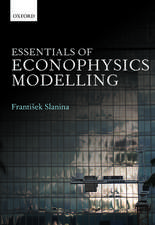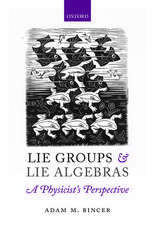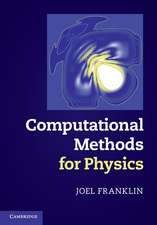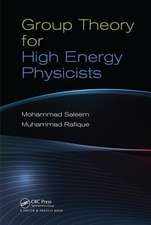The Lattice Boltzmann Method: Principles and Practice: Graduate Texts in Physics
Autor Timm Krüger, Halim Kusumaatmaja, Alexandr Kuzmin, Orest Shardt, Goncalo Silva, Erlend Magnus Viggenen Limba Engleză Hardback – 17 noi 2016
To aid beginners, the most essential paragraphs in each chapter are highlighted, and the introductory chapters on various LB topics are front-loaded with special "in a nutshell" sections that condense the chapter's most important practical results. Together, these sections can be used to quickly get up and running with the method. Exercises are integrated throughout the text, and frequently asked questions about the method are dealt with in a special section at the beginning. In the book itself and through its web page, readers can find example codes showing how the LB method can be implemented efficiently on a variety of hardware platforms, including multi-core processors, clusters, and graphics processing units. Students and scientists learning and using the LB method will appreciate the wealth of clearly presented and structured information in this volume.
| Toate formatele și edițiile | Preț | Express |
|---|---|---|
| Paperback (1) | 470.77 lei 6-8 săpt. | |
| Springer International Publishing – 22 apr 2018 | 470.77 lei 6-8 săpt. | |
| Hardback (1) | 600.98 lei 6-8 săpt. | |
| Springer International Publishing – 17 noi 2016 | 600.98 lei 6-8 săpt. |
Din seria Graduate Texts in Physics
- 15%
 Preț: 470.35 lei
Preț: 470.35 lei - 15%
 Preț: 641.32 lei
Preț: 641.32 lei - 17%
 Preț: 528.35 lei
Preț: 528.35 lei - 20%
 Preț: 570.34 lei
Preț: 570.34 lei - 17%
 Preț: 495.90 lei
Preț: 495.90 lei -
 Preț: 448.46 lei
Preț: 448.46 lei - 17%
 Preț: 495.46 lei
Preț: 495.46 lei - 20%
 Preț: 637.49 lei
Preț: 637.49 lei - 15%
 Preț: 527.37 lei
Preț: 527.37 lei - 17%
 Preț: 461.46 lei
Preț: 461.46 lei -
 Preț: 276.40 lei
Preț: 276.40 lei - 20%
 Preț: 695.16 lei
Preț: 695.16 lei - 17%
 Preț: 494.60 lei
Preț: 494.60 lei -
 Preț: 360.94 lei
Preț: 360.94 lei - 15%
 Preț: 589.07 lei
Preț: 589.07 lei - 20%
 Preț: 762.11 lei
Preț: 762.11 lei - 20%
 Preț: 700.71 lei
Preț: 700.71 lei - 15%
 Preț: 475.03 lei
Preț: 475.03 lei - 15%
 Preț: 638.28 lei
Preț: 638.28 lei - 15%
 Preț: 656.61 lei
Preț: 656.61 lei - 15%
 Preț: 712.59 lei
Preț: 712.59 lei - 19%
 Preț: 460.08 lei
Preț: 460.08 lei -
 Preț: 448.26 lei
Preț: 448.26 lei - 15%
 Preț: 525.29 lei
Preț: 525.29 lei - 18%
 Preț: 741.11 lei
Preț: 741.11 lei -
 Preț: 448.46 lei
Preț: 448.46 lei -
 Preț: 414.16 lei
Preț: 414.16 lei -
 Preț: 397.36 lei
Preț: 397.36 lei - 15%
 Preț: 588.74 lei
Preț: 588.74 lei -
 Preț: 382.22 lei
Preț: 382.22 lei - 15%
 Preț: 591.47 lei
Preț: 591.47 lei -
 Preț: 390.94 lei
Preț: 390.94 lei - 15%
 Preț: 592.29 lei
Preț: 592.29 lei - 15%
 Preț: 586.66 lei
Preț: 586.66 lei -
 Preț: 396.98 lei
Preț: 396.98 lei - 15%
 Preț: 520.56 lei
Preț: 520.56 lei - 15%
 Preț: 630.09 lei
Preț: 630.09 lei -
 Preț: 372.81 lei
Preț: 372.81 lei -
 Preț: 493.21 lei
Preț: 493.21 lei - 18%
 Preț: 1087.31 lei
Preț: 1087.31 lei - 18%
 Preț: 798.68 lei
Preț: 798.68 lei - 15%
 Preț: 600.47 lei
Preț: 600.47 lei -
 Preț: 381.63 lei
Preț: 381.63 lei - 15%
 Preț: 535.34 lei
Preț: 535.34 lei
Preț: 600.98 lei
Preț vechi: 707.03 lei
-15% Nou
Puncte Express: 901
Preț estimativ în valută:
115.08€ • 118.71$ • 95.37£
115.08€ • 118.71$ • 95.37£
Carte tipărită la comandă
Livrare economică 20 februarie-06 martie
Preluare comenzi: 021 569.72.76
Specificații
ISBN-13: 9783319446479
ISBN-10: 3319446479
Pagini: 694
Ilustrații: XXIV, 694 p. 126 illus.
Dimensiuni: 155 x 235 x 44 mm
Greutate: 1.18 kg
Ediția:1st ed. 2017
Editura: Springer International Publishing
Colecția Springer
Seria Graduate Texts in Physics
Locul publicării:Cham, Switzerland
ISBN-10: 3319446479
Pagini: 694
Ilustrații: XXIV, 694 p. 126 illus.
Dimensiuni: 155 x 235 x 44 mm
Greutate: 1.18 kg
Ediția:1st ed. 2017
Editura: Springer International Publishing
Colecția Springer
Seria Graduate Texts in Physics
Locul publicării:Cham, Switzerland
Cuprins
Part I Background: Basics of hydrodynamics and kinetic theory.- Numerical methods for fluids.- Part II Lattice Boltzmann fundamentals: The lattice Boltzmann equation.- Analysis of the lattice Boltzmann equation.- Boundary and initial conditions.- Forces.- Non-dimensionalisation and choice of simulation parameters.- Part III Lattice Boltzmann extensions, improvements, and details: Lattice-Boltzmann for advection-diffusion-problems.- Multiphase and multi-component flows.- MRT and TRT collision operators.- Boundary conditions for fluid-structure interaction.- Sound waves.- Part IV Numerical implementation of the lattice Boltzmann method: Implementation of LB Simulations.- Appendices.
Recenzii
“The aim of this book is to give a thorough description of the field and to provide researchers and graduate students with powerful tools so that they can immediately apply their knowledge to practical applications. … readers can find example codes showing how the lattice Boltzmann method can be implemented efficiently on a variety of hardware platforms such as clusters, multi-core processors, and graphics processing units. The rich information included in this volume is clearly presented and well structured.” (Teodora-Liliana Rădulescu, zbMATH 1362.76007, 2017)
Notă biografică
Timm Krüger is a Chancellor's Fellow at the School of Engineering, University of Edinburgh, UK. He obtained his PhD in Physics from Bochum University in 2011. His research interests include suspensions, interfacial phenomena, microfluidics and biophysical applications of blood flow.
Halim Kusumaatmaja is a Lecturer (Assistant Professor) at the Department of Physics, Durham University, UK. He obtained his PhD in Theoretical Condensed Matter Physics from the University of Oxford. He has a broad range of interests in Soft Matter and Biophysics, including wetting phenomena, membrane biophysics, liquid crystals and colloidal systems.
Alexandr Kuzmin is a Thermal/CFD Software Engineer at Maya Heat Transfer Technologies. He holds a PhD in CFD from the University of Calgary (Mechanical Engineering Department). He has a broad experience in computational geometry, heat and mass transfer, and numerical methods applied to industrial and research problems.
Orest Shardt is a postdoctoral research fellow in Mechanical and Aerospace Engineering at Princeton University. He graduated from the University of Alberta in 2014 with a PhD in chemical engineering. His main research interests are high performance computing and interfacial and electrokinetic phenomena in multiphase flows.
Goncalo Silva is a postdoctoral researcher in Mechanical Engineering at IDMEC/IST, University of Lisbon, from where he graduated in 2013 with a PhD in Mechanical Engineering. Between 2013 and 2016, he developed his postdoctoral research at IRSTEA, Antony, France. His main research interests are in the field of microfluidics and flows in porous media.
Erlend Magnus Viggen is a research scientist at SINTEF. He has a Master's in Applied Physics (2009) and a PhD in Acoustics (2014), both from the Norwegian University of Science and Technology. His main research interests are physical and computational acoustics.
Halim Kusumaatmaja is a Lecturer (Assistant Professor) at the Department of Physics, Durham University, UK. He obtained his PhD in Theoretical Condensed Matter Physics from the University of Oxford. He has a broad range of interests in Soft Matter and Biophysics, including wetting phenomena, membrane biophysics, liquid crystals and colloidal systems.
Alexandr Kuzmin is a Thermal/CFD Software Engineer at Maya Heat Transfer Technologies. He holds a PhD in CFD from the University of Calgary (Mechanical Engineering Department). He has a broad experience in computational geometry, heat and mass transfer, and numerical methods applied to industrial and research problems.
Orest Shardt is a postdoctoral research fellow in Mechanical and Aerospace Engineering at Princeton University. He graduated from the University of Alberta in 2014 with a PhD in chemical engineering. His main research interests are high performance computing and interfacial and electrokinetic phenomena in multiphase flows.
Goncalo Silva is a postdoctoral researcher in Mechanical Engineering at IDMEC/IST, University of Lisbon, from where he graduated in 2013 with a PhD in Mechanical Engineering. Between 2013 and 2016, he developed his postdoctoral research at IRSTEA, Antony, France. His main research interests are in the field of microfluidics and flows in porous media.
Erlend Magnus Viggen is a research scientist at SINTEF. He has a Master's in Applied Physics (2009) and a PhD in Acoustics (2014), both from the Norwegian University of Science and Technology. His main research interests are physical and computational acoustics.
Textul de pe ultima copertă
This book is an introduction to the theory, practice, and implementation of the Lattice Boltzmann (LB) method, a powerful computational fluid dynamics method that is steadily gaining attention due to its simplicity, scalability, extensibility, and simple handling of complex geometries. The book contains chapters on the method's background, fundamental theory, advanced extensions, and implementation.
To aid beginners, the most essential paragraphs in each chapter are highlighted, and the introductory chapters on various LB topics are front-loaded with special "in a nutshell" sections that condense the chapter's most important practical results. Together, these sections can be used to quickly get up and running with the method. Exercises are integrated throughout the text, and frequently asked questions about the method are dealt with in a special section at the beginning. In the book itself and through its web page, readers can find example codes showing how the LB method can be implemented efficiently on a variety of hardware platforms, including multi-core processors, clusters, and graphics processing units. Students and scientists learning and using the LB method will appreciate the wealth of clearly presented and structured information in this volume.
To aid beginners, the most essential paragraphs in each chapter are highlighted, and the introductory chapters on various LB topics are front-loaded with special "in a nutshell" sections that condense the chapter's most important practical results. Together, these sections can be used to quickly get up and running with the method. Exercises are integrated throughout the text, and frequently asked questions about the method are dealt with in a special section at the beginning. In the book itself and through its web page, readers can find example codes showing how the LB method can be implemented efficiently on a variety of hardware platforms, including multi-core processors, clusters, and graphics processing units. Students and scientists learning and using the LB method will appreciate the wealth of clearly presented and structured information in this volume.
Caracteristici
A textbook that is strong on basics but also includes in-depth descriptions of the latest applications of LBM Thorough chapter summaries, example codes, and an FAQ make this book suitable as both textbook and handbook for practitioners The book webpage gives the full code corresponding to the examples presented in the text















